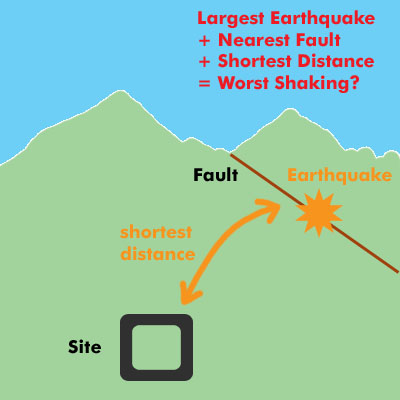Determinism
Deterministic seismic hazard is the first method to go beyond observations of effects and look at the causes of seismicity. The object of the deterministic method is to answer the question, "what is the worst that could happen in an earthquake?". If you design for the worst thing possible, then you are bound to be safe. The stages in the method are:
- Find the nearest active fault
- Calculate the largest earthquake that could happen on this fault
- Assume the largest earthquake happens at the closest point to your site
- Calculate what the ground motion will be
The advantages of this method are (a) that it is relatively easily to do, and (b) it gives you a conservative answer ("conservative" in this context means a value that maximises safety). The disadvantages are (a) often you don't know where the active faults are (several of the largest Californian earthquakes of recent years have occurred on faults that previously were unknown) and (b) it's easy to come up with grossly over-conservative hazard values as the largest earthquake possible on a fault may be about as common as a 50-ton meteorite impact. Possible, but not likely.
Recently an attempt has been made to improve the deterministic method. Firstly, by including source areas as well as faults, one can overcome the problem of hidden faults that you don't know about. Secondly, the over-conservatism is addressed by modelling not the maximum possible earthquake, but the "expected" earthquake in the lifetime of the facility you are designing. A phrase one sometimes hears is the "negotiated earthquake" - that is, the event that can be agreed, by everyone involved with a project, is "sufficient" for design purposes. The danger here is that one may be going from over-conservatism to under-conservatism in that no allowance is made for the possibility that an earthquake may occur that is a bit larger than what you were expecting. However, the simplicity of the method is attractive, and it may give a sufficient approximation to the hazard for structures where the consequences of failure are not too great.
Another case where a deterministic approach is appropriate is where a very large earthquake is so likely that you may as well just model it directly - you can't ignore it!
Note that deterministic analysis does not remove all uncertainty from hazard. The maximum earthquake that can occur on a fault is never known perfectly, it can only be estimated within a likely range of values. And you can never be sure exactly how strong will be the ground motion at a site even if you know the magnitude and the distance.



